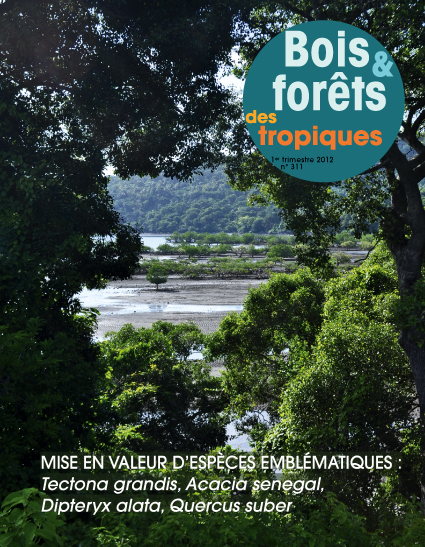Sorption et propriétés thermodynamiques du liège pour les isothermes 35ºC et 50ºC
DOI :
https://doi.org/10.19182/bft2012.311.a20512Mots-clés
liège, désorption, hygroscopicité, isotherme, chaleur isostérique, sorption, thermodynamiqueRésumé
Les caractéristiques du liège font de lui un élément irremplaçable dans le domaine de l'industrie bouchonnière de bouteilles de vin et de champagne de grande qualité. Les études portant sur les relations eau-liège sont peu nombreuses, particulièrement en ce qui concerne le comportement thermodynamique du liège. Dans cette étude, l'hygroscopicité et les propriétés thermodynamiques sur deux échantillons de liège de la même qualité, l'un extrait en 1968 et l'autre en 2006, ont été étudiées afin de déterminer les possibles différences de comportement au fur et à mesure que le temps passe. Pour ce faire, les isothermes de sorption de 35 °C et de 50 °C ont été construites suivant la méthode des solutions de sels saturées, en ajustant les valeurs conformément à la méthode GAB. Des coefficients d'hystérésis ont été utilisés dans la comparaison des isothermes, des spectres d'infrarouge dans l'étude des possibles modifications chimiques de la paroi cellulaire et la méthode d'intégration de l'équation de Clausius-Clapeyron dans la détermination des paramètres thermodynamiques. Aucune différence significative n'a été observée entre les teneurs en humidité d'équilibre obtenues pour les deux lièges ; par contre, les pourcentages de saturation de la monocouche sont significativement inférieurs dans le plus vieux des lièges. Pour les deux types de liège, tout comme pour le bois, les valeurs des points d'inflexion où la physisorption commence à dominer sur la chimisorption sont très similaires, environ 31-35 % d'humidité relative (RH). En ce qui concerne les propriétés thermodynamiques, les courbes de chaleur isostérique nette sont similaires à celles qui sont obtenues pour le bois, et l'énergie de liaison du liège extrait en 2006 est inférieure à celle du liège extrait en 1968.Téléchargements
Références
ABDULLA G., BELGHIT A., ALLAF K., 2009. Impact of instant controlled pressure drop treatment on moisture adsorption isotherm of cork granules. Drying Technology, 27 (2): 237-247.
AL-MUHTASEB A. H., MCMINN W. A. M., MAGEET. R. A., 2004. Water
sorption isothermsof starch powders. Part 2: Thermodynamic characteristics. Journal of Food Engineering, 62 (2): 135-142.
AVRAMIDISS., 1992. Enthalpy-entropy compensation and thermodynamic considerations in sorption phenomena. Wood Science and Technology, 26(5): 329-333.
AVRAMIDIS S., 1997. The basis of sorption. In: Proceedings of International Conference of COST Action E8: Mechanical Performance of Wood and Wood Products, 16-17 June 1997. Copenhagen, Denmark, 1-16.
BARDET M., FORAY M. F., MARON S., GONCALVES P., TRÂN Q. K.,
Characterization of wood components of Portuguese medieval dugout canoes with high-resolution solid-state NMR. Carbohydrate Polymers, 57 (4): 419-424.
CORREA P. C., GONELI A. L. D., JUNIOR P. C. A., DE OLIVEIRA G.
H. H, VALENTE D. S. M., 2010. Moisture sorption isotherms and isosteric heat of sorption of coffee in different processing levels. International Journal of Food Science and Technology, 45 (10): 2016-2022.
DE PALACIOS P., ESTEBAN L. G., FERNÁNDEZ F. G., GARCÍA-IRUELA A., GONZÁLEZ-ADRADOS J. R., CONDE M., 2011. Comparative
study of the 35°C sorption isotherms of cork stripped from the tree in 1968 and 2006. BioResources, 6 (2): 2135-2144.
ESTEBAN L. G., GUINDEO A., DE PALACIOS P., FERNÁNDEZ F. G.,
Saturated salt method determination of hysteresis of Pinus sylvestris L. wood for 35°C isotherms. Materiales de construcción, 54 (276): 51-64.
ESTEBAN L. G., GRIL J., DE PALACIOS P., GUINDEO A., 2005. Reduc-
tion of wood hygroscopicity and associated dimensional response by repeated humidity cycles. Annals of Forest Science, 62 (3): 275-284.
ESTEBAN L. G., FERNÁNDEZ F. G., GUINDEO A., DE PALACIOS P.,
GRIL J., 2006. Comparison of the hygroscopic behaviour of 205year-old and recently cut juvenile wood from Pinus sylvestris L. Annals of Forest Science, 63 (3): 309-317.
ESTEBAN L. G., DE PALACIOS P., FERNÁNDEZ F. G., GUINDEO A.,
CANO N. N., 2008a. Sorption and thermodynamic properties of old and new Pinussylvestris wood. Wood and Fiber Science, 40 (1): 111-121.
ESTEBAN L. G., DE PALACIOS P., FERNÁNDEZ F. G., GUINDEO A.,
CONDE M., BAONZA V., 2008b. Sorption and thermodynamic properties of juvenile Pinus sylvestris L. wood after 103 years of submersion. Holzforschung, 62 (6): 745-751.
ESTEBAN L. G., DE PALACIOS P., FERNÁNDEZ F. G., MARTÍN J. A.,
GÉNOVA M., FERNÁNDEZ-GOLFÍN J. I., 2009. Sorption and thermodynamic propertiesof buried juvenile Pinussylvestris L. wood aged 1,170 ± 40 BP. Wood Science and Technology, 43 (7-8): 679-690.
ESTEBAN L. G., DE PALACIOS P., FERNÁNDEZ F. G., GARCÍA-AMO-
RENA I., 2010. Effects of burial of Quercus spp. wood aged 5,910
± 250 BP on sorption and thermodynamic properties. International biodeterioration biodegradation, 64 (5): 371-377.
FAO, 2002. Evaluación de los recursos forestales mundiales 2000: Informe principal. Rome, Italy, Food and Agriculture Organization of the United Nations, 500 p.
FENGEL D., 1991. Aging and fossilization of wood and its components. Wood Science and Technology, 25 (3): 153-177.
GIL L., CORTICO P., 1998. Cork hygroscopic equilibrium moisture content. Holz als Rohund Werkstoff, 56 (5): 355-358.
GONZÁLEZ-ADRADOS J. R., HARO R. M. C., 1994. Variación de la
humedad de equilibrio del corcho en plancha con la humedad relativa. Modelos de regresión no lineal para las isotermas de adsorción. Investigación Agraria. Sistemas y Recursos Forestales, 3 (2): 199-209.
GONZÁLEZ-ADRADOS J. R., GONZÁLEZ-HERNÁNDEZ F., DE CECA
J. L. C., CÁCERES-ESTEBAN M. J., GARCÍA-VALLEJO A. C., 2008. Wine absorption by cork stoppers. Spanish Journal of Agricultural Research, 6 (4): 645-649.
IPROCOR, 2004. Estadisticas de exportacion de corcho extremeno 1999. www.iprocor.org
JOWITT R., WAGSTAFFE P. J., 1989. The certification of the water content of microcrystalline cellulose (MCC) at 10 water activities, CRM
EUR 12429. Luxembourg, Luxembourg, Commission of the European Communities, Community Bureau of Reference, 54 p.
Téléchargements
Numéro
Rubrique
-
Résumé239
-
PDF200
Publié
Comment citer
Licence
 Les articles sont publiés en Accès libre. Ils sont régis par le Droit d'auteur et par les licenses créative commons. La license utilisée est Attribution (CC BY 4.0).
Les articles sont publiés en Accès libre. Ils sont régis par le Droit d'auteur et par les licenses créative commons. La license utilisée est Attribution (CC BY 4.0).









